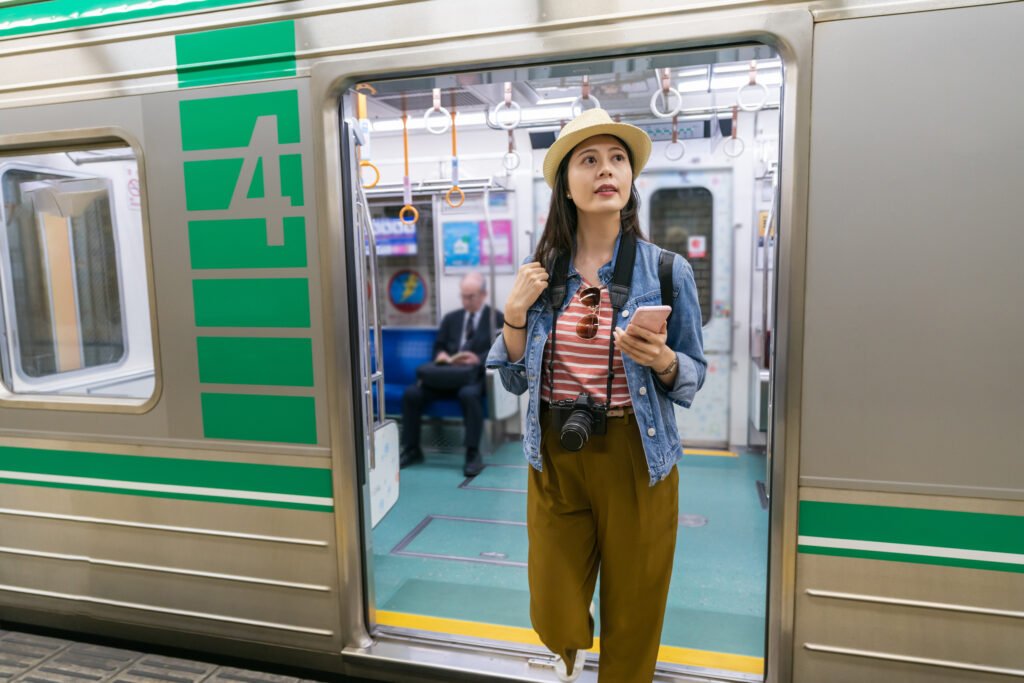Japan’s rail system is renowned for its efficiency, punctuality, and extensive network, making it an excellent way to explore the country. Here’s a comprehensive guide to help you navigate the Japanese rail system with ease.

Understanding the Rail Network
Japan’s rail network includes several types of trains operated by the Japan Railways Group (JR Group) and various private rail companies. The JR Group is divided into regional companies such as JR East, JR West, JR Central, JR Kyushu, JR Shikoku, and JR Hokkaido. These companies manage the majority of long-distance and regional trains, including the famous Shinkansen (bullet train).
Types of Trains:
- Shinkansen (Bullet Trains): These high-speed trains connect major cities and are known for their speed and punctuality. They operate on dedicated tracks and have separate ticket gates and platforms (shinkansen).
- Limited Express (Tokkyu): Fast trains that stop only at major stations, offering a quicker alternative to local trains (tokkyu).
- Express and Rapid (Kyuko, Kaisoku): These trains make fewer stops than local trains, providing a faster service without the need for seat reservations (kyuko, kaisoku).
- Local Trains (Futsuu Densha): These stop at every station and are ideal for short distances and regional travel (futsuu densha).
Tickets and Passes
For tourists, the Japan Rail Pass (JR Pass) is highly recommended. It offers unlimited travel on JR trains, including Shinkansen, and is available in 7, 14, or 21-day options. This pass must be purchased before arriving in Japan and can be a cost-effective way to travel, especially if you plan to visit multiple cities.
Using the JR Pass:
- The JR Pass is valid on all JR trains, including Shinkansen (except Nozomi and Mizuho trains), local trains, and some buses and ferries.
- Passes can be activated at JR ticket offices, where you can also make seat reservations for no extra charge.
- Keep your pass accessible, as you will need to show it when entering and exiting JR stations.
Navigating Stations
Japan’s train stations, especially in major cities, can be vast and complex. Here are some tips to help you navigate them:
- Signage: Look for bilingual signs (Japanese and English) that guide you to platforms, exits, and facilities.
- Ticket Machines: Most stations have multilingual ticket machines that are easy to use. For long-distance travel, consider reserving seats at the Midori no Madoguchi (ticket office).
- Platform Etiquette: Stand in line at the designated spots on the platform. Pay attention to the electronic signs that display train information, including the car number and boarding position.
Travel Tips
- Apps and Tools: Use travel apps like Hyperdia or Google Maps to plan your journey and check train schedules.
- Luggage: Shinkansen trains have luggage storage areas, but space can be limited. Consider using luggage delivery services for large bags.
- Food and Drink: Eating and drinking are generally allowed on long-distance trains like Shinkansen. You can buy bento boxes (ekiben) at stations to enjoy during your trip.
By understanding these basics, you can confidently navigate Japan’s rail system and enjoy a smooth travel experience.
How to Ride Japanese Trains: Manners and Etiquette with an Explanation Why
Riding trains in Japan involves more than just transportation; it’s about respecting the shared space and maintaining a harmonious environment. Here are some key manners and the reasons behind them:
Manners on Japanese Trains
- Queueing: Always stand in line when waiting for the train. There are marked areas on the platform indicating where to queue. This orderly system ensures efficient boarding and deboarding.
- Silence: Keep conversations to a minimum and speak quietly. Japanese trains are typically very quiet, allowing passengers to relax or work without disturbance. This respect for others’ personal space is a cultural norm.
- Priority Seats (Yuusenseki): Leave designated priority seats for the elderly, pregnant women, and those with disabilities. Even if the train is crowded, these seats should remain available for those in need (yuusenseki).
- No Eating or Drinking on Local Trains: While it’s acceptable to eat and drink on long-distance trains like Shinkansen, it’s considered rude on local and commuter trains. This helps maintain cleanliness and avoids unpleasant odors in a confined space.
- Mobile Phones: Set your phone to silent mode (known as “manner mode”) and avoid talking on the phone while on the train. Messaging and non-intrusive phone use are generally acceptable.
Why These Rules Matter
These manners are deeply rooted in Japanese culture, which places a high value on respect and consideration for others. The emphasis on maintaining a peaceful and orderly environment reflects the collective ethos of Japanese society, where harmony and respect for personal space are paramount.
By following these guidelines, travelers can show respect for local customs and contribute to a pleasant travel experience for everyone.
These insights should help you navigate and enjoy your travels on Japan’s extensive and efficient rail network. Safe travels!
